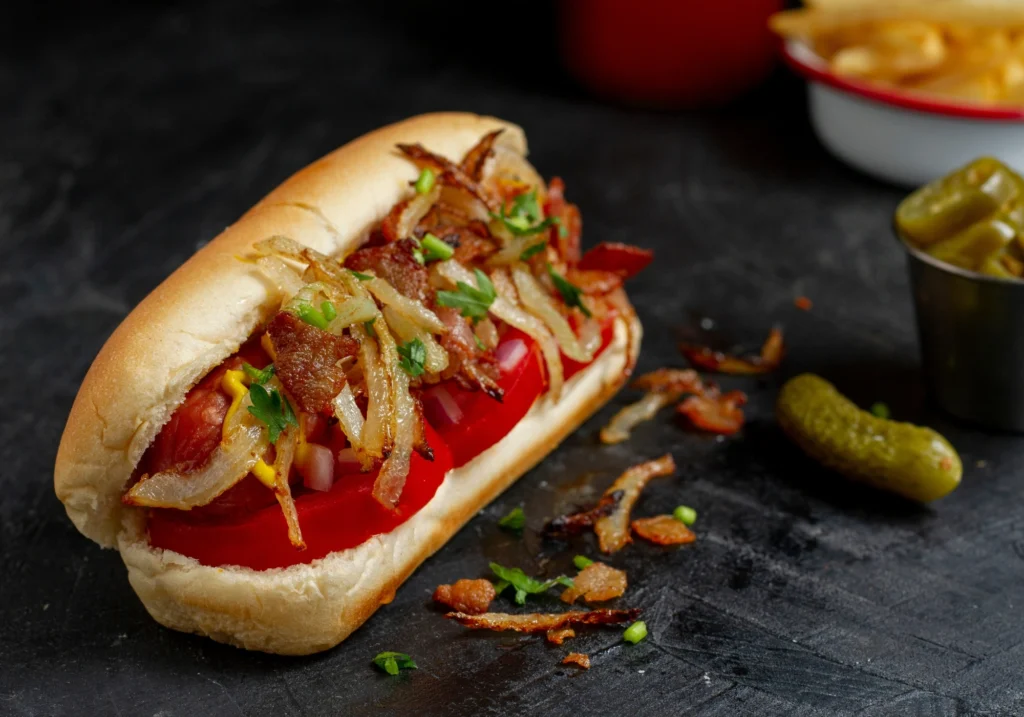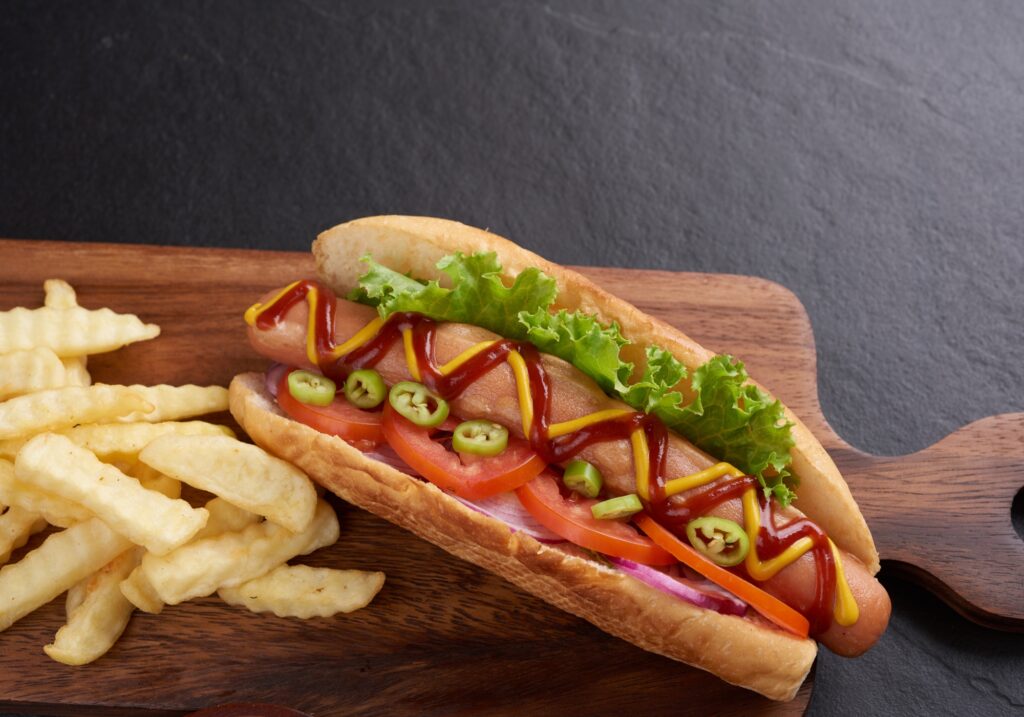Imagine a sizzling frankfurter nestled in a soft bun, topped with a symphony of condiments. This quintessential image of a hot dog evokes memories of ballpark excitement, backyard barbecues, and simple street-side pleasures.
Yet, beneath its unassuming exterior lies a rich history and a surprisingly diverse culinary landscape. For many, this culinary icon is more than just food; it’s a symbol of casual enjoyment, and a canvas for endless flavor combinations.
However, despite its widespread popularity, many people are unaware of its fascinating journey from a German street food to an American classic and a global phenomenon. This article promises to unravel the complete story of this staple, providing an in-depth look at its origins, the various forms it takes around the world, and its enduring appeal.
By the end, you’ll have a newfound appreciation for this beloved culinary item, armed with knowledge to truly savor every bite. Prepare to embark on a flavorful exploration that will undoubtedly enhance your next experience with this classic.

Summary Table: Hot Dog
| Feature | Description |
| Origin | Debated, but widely attributed to Germany (Frankfurt/Vienna) in the 15th-19th centuries. |
| Arrival in US | Mid-19th century with German immigrants; popularized as “dachshund sausages.” |
| Key Components | Sausage (frankfurter/wiener), bun, and customizable condiments. |
| Popular US Styles | New York (mustard, sauerkraut), Chicago (all-beef, “dragged through the garden”), Coney Island (meat sauce), Seattle (cream cheese). |
| Global Variations | Korean Corn Dog (battered, fried), Danish Pølse (red sausage), Chilean Completo (mayo, tomato, avocado/sauerkraut). |
| Cooking Methods | Grilling, boiling, pan-frying, steaming. |
| Cultural Impact | Iconic at sports events, festivals, and summer celebrations. |
| Economic Impact | Significant industry for meat processing, agriculture, food service, and retail. |
| Dietary Trends | Growing availability of organic, gluten-free, and plant-based frankfurter options. |
What is an Hot Dog? Defining the Iconic Sausage
A hot dog, at its most fundamental level, is a cooked sausage, traditionally grilled or steamed, and served in a longitudinally sliced bun. The sausage itself is typically made from a mixture of ground meat, often pork, beef, or a combination of both, along with various seasonings, spices, and sometimes fillers.
The defining characteristic of this dish lies in its specific preparation and serving style, which distinguishes it from other types of encased meats.
The Anatomy of a Classic Frankfurter
Understanding the components of this beloved street food reveals why it’s such a versatile and cherished item.
-
- The Sausage (Frankfurter/Wiener): This is the heart of the offering. While often referred to generically as an hot dog, the sausage itself can be a frankfurter (typically all beef) or a wiener (often a blend of pork and beef). The meat is finely ground, seasoned, and encased, traditionally in a natural casing (which provides a satisfying “snap” when bitten) or a collagen casing.
-
- The Bun: A soft, often slightly sweet, white bread bun is the standard vessel for holding the sausage. It’s designed to cradle the sausage and contain the condiments, making it easy to eat on the go.
-
- Condiments and Toppings: This is where the simple sausage truly transforms. From classic ketchup and mustard to more elaborate combinations like sauerkraut, chili, cheese, onions, and relish, toppings are highly customizable and often define regional styles of this popular dish.
The convenient and effective design of this item makes it a perfect food for quick consumption and communal enjoyment, contributing to its enduring popularity.
As we’ve explored the basic definition and components of this food, it’s clear that its essence lies in the combination of sausage, bun, and toppings. This simplicity, however, has allowed for incredible diversity, as we’ll discover when we delve into its fascinating origins.
The Storied History of the Frank: From Germany to Global Icon
The journey of the hot dog from a humble European sausage to a worldwide culinary sensation is a compelling narrative of immigration, innovation, and cultural assimilation. Its roots are firmly planted in Germany, but its iconic status was truly cemented in the United States.
European Ancestry: Where the Iconic Sausage Began
The concept of a sausage served in bread or as a street food can be traced back centuries in Europe.
-
- Frankfurt, Germany: Many culinary historians credit Frankfurt am Main with creating the “frankfurter,” a slender, smoked sausage made from pork. This sausage gained popularity in the 13th century and was reportedly served during imperial coronations.
-
- Vienna, Austria: Another strong contender for the origin of this particular encased meat is Vienna, where the “wiener” (short for Wiener Würstchen, or Viennese sausage) was developed. Wieners are typically a blend of pork and beef. The exact city that first put a sausage in a bun is debated, but both Frankfurt and Vienna played crucial roles in developing the sausage itself.
These early sausages were portable and flavorful, making them ideal for consumption at markets and public gatherings.
From its European heritage, this culinary delight made a significant transatlantic voyage, setting the stage for its American transformation. Understanding its immigration story is key to appreciating its widespread adoption and evolution.
The Frankfurter’s American Dream: From Street Cart to Ballpark Staple
The true boom of this popular food began with German immigrants arriving in the United States during the 19th century. They brought with them their beloved sausages, which quickly found a new home and identity.
-
- Early American Adoption: German butchers and street vendors began selling “dachshund sausages” from pushcarts in New York City in the 1860s. The long, thin sausages reminded people of dachshund dogs, hence the moniker.
-
- The Birth of the Bun: The idea of serving the sausage in a bun is widely attributed to various vendors. One popular theory credits Anton Feuchtwanger, a German immigrant who sold these savory items in St. Louis in the 1880s. To prevent his customers from burning their hands, he reportedly lent them white gloves, which were rarely returned. His wife suggested putting the sausages in a split roll instead, and a culinary legend was born.
-
- Baseball and Beyond: This encased meat’s association with baseball parks began in the late 19th and early 20th centuries. Harry Stevens, a concessionaire at New York’s Polo Grounds, is often credited with popularizing the frank at sporting events, further cementing its status as an American classic. The convenience of eating this item while watching a game made it an instant hit.
The journey of this prepared sausage from a European street food to an American icon showcases its adaptability and universal appeal. Now that we’ve traced its historical path, let’s explore the incredible array of varieties that have emerged, each with its own unique flavor profile and regional identity.
Exploring Diverse Frankfurter Varieties and Regional Styles
The beauty of the hot dog lies in its remarkable versatility. While the basic components remain consistent, the type of sausage, the bun, and especially the array of toppings create an astonishing spectrum of flavors and textures. From coast to coast in the United States and across the globe, distinct regional styles of this popular dish have emerged, each a reflection of local tastes and culinary traditions.
Iconic American Frankfurter Creations
The United States, having embraced the frankfurter as its own, boasts a rich tapestry of regional variations. Each style is a testament to local pride and culinary innovation.
-
- New York Style Sausage: Often found from street vendors, these are typically all-beef frankfurters, boiled or grilled, served on a plain bun with brown mustard and sauerkraut, or sometimes a pushcart-style onion sauce. The simplicity highlights the quality of the sausage.
-
- Chicago-Style Hot Dog: A true masterpiece of toppings, the Chicago-style hot dog is an all-beef frankfurter on a poppy seed bun, “dragged through the garden” with yellow mustard, chopped white onions, bright green sweet pickle relish, a dill pickle spear, tomato slices or wedges, pickled sport peppers, and a dash of celery salt. Ketchup is famously omitted. You can learn more about its unique rules in our article on Chicago Hot Dog Etiquette.
-
- Coney Island Style (Michigan/Detroit/Jackson): While “Coney Island” might evoke images of New York, this style, originating in Michigan, refers to a sausage topped with a hearty, often chili-like, meat sauce (known as Coney sauce or Coney chili), typically with mustard and chopped onions. Variations exist across Michigan cities.
-
- Fenway Frank (Boston): A staple at Fenway Park, this particular frankfurter is boiled and grilled, served on a New England-style split-top bun, usually with mustard and relish. The unique bun, grilled on the sides, sets it apart.
-
- Seattle-Style Sausage: A distinct and surprisingly delicious combination, this offering features a split sausage, often grilled, stuffed with cream cheese and topped with grilled onions and various other condiments.
-
- Sonoran Style (Arizona/Mexico): This unique creation wraps a frankfurter in bacon, grills it, and serves it in a bolillo roll (a Mexican bread) with pinto beans, onions, tomatoes, salsa verde, and a drizzle of mayonnaise or crema. It’s a vibrant fusion of flavors.
These regional differences highlight how a single food can be interpreted in countless delicious ways. Beyond the American landscape, the global reach of this item is even more impressive, demonstrating its universal appeal.
Sausages Around the World: Global Interpretations
The adaptable nature of this food has allowed it to seamlessly integrate into diverse culinary traditions across the globe, often taking on unique local characteristics.
-
- Germany (Wurst in Brötchen): While the birthplace of the sausage, these prepared meats are typically served as a “Wurst in Brötchen” (sausage in a roll) with mustard, often without the elaborate toppings found in the US.
-
- South Korea (Korean Corn Dog/Hotdog): Far from the American version, the Korean “hotdog” is a battered and deep-fried sausage (often with mozzarella cheese inside), served on a stick and frequently coated with sugar, ketchup, and mustard. It’s a popular street food snack. Discover more about this trend in our piece on Korean Street Food Delights.
-
- Japan (Yakitori-style, Hotto Doggu): In Japan, frankfurters can be found in various forms. “Hotto Doggu” refers to the American-style version, but you might also find sausages grilled yakitori-style (on skewers) or incorporated into other dishes.
-
- Scandinavia (Pølse): Especially popular in Denmark, “pølse” (sausage) stands are ubiquitous. These items are served in a variety of ways, including “rød pølse” (red sausage) in a bun with remoulade, mustard, ketchup, crispy fried onions, and pickles.
-
- Chile (Completo): The Chilean “completo” lives up to its name, meaning “complete.” It’s a sausage overflowing with toppings, most commonly mayonnaise, diced tomatoes, and sauerkraut. Avocado is also a popular addition.
This global tour demonstrates the incredible chameleon-like ability of this food to adapt to local ingredients and preferences. From its diverse varieties, we can see how the frankfurter has become a culinary canvas. Next, we will explore the different ways it can be cooked, from grilling to steaming, each method imparting a unique flavor and texture.
How to Prepare a Perfect Frankfurter: Cooking Methods and Serving Tips
Preparing an hot dog might seem straightforward, but mastering different cooking methods can elevate the experience, bringing out unique flavors and textures from the sausage. Each approach offers its own advantages, from the smoky char of grilling to the tender consistency of seaming.
Popular Cooking Techniques for Sausages
The way you cook this beloved sausage significantly impacts its taste and texture. Here are some of the most common and effective methods.
-
- Grilling: This is arguably the most popular method, especially for outdoor cooking. Grilling imparts a smoky flavor and a slightly charred exterior, often creating appealing grill marks.
-
- How-To: Preheat your grill to medium heat. Place these sausages directly on the grates, turning frequently to ensure even cooking and to prevent burning. Cook until browned and heated through, typically 5-7 minutes.
-
- Grilling: This is arguably the most popular method, especially for outdoor cooking. Grilling imparts a smoky flavor and a slightly charred exterior, often creating appealing grill marks.
-
- Boiling/Simmering: A simple and effective method that results in a tender, plump sausage. It’s often favored for street vendors as it keeps the items warm and juicy.
-
- How-To: Bring a pot of water to a rolling boil. Reduce heat to a simmer and add the frankfurters. Cook for 3-5 minutes, or until heated through. Avoid over-boiling, which can cause the casings to burst.
-
- Boiling/Simmering: A simple and effective method that results in a tender, plump sausage. It’s often favored for street vendors as it keeps the items warm and juicy.
-
- Pan-Frying/Searing: Great for indoor cooking, this method allows for a nice browning and can create a slightly crispy exterior.
-
- How-To: Heat a small amount of oil or butter in a skillet over medium heat. Add the sausages and cook, turning occasionally, until browned and heated through, about 5-8 minutes.
-
- Pan-Frying/Searing: Great for indoor cooking, this method allows for a nice browning and can create a slightly crispy exterior.
-
- Steaming: This gentle method yields a very tender and evenly cooked frankfurter, often preferred for a classic “snap” if using natural casing items.
-
- How-To: Use a steamer basket over simmering water. Place the sausages in the basket, cover, and steam for 5-7 minutes, or until heated through.
-
- Steaming: This gentle method yields a very tender and evenly cooked frankfurter, often preferred for a classic “snap” if using natural casing items.
-
- Microwaving: While quick, this method is generally not recommended for optimal flavor or texture, as it can result in a rubbery sausage. Use only when time is extremely limited.
-
- How-To: Place the item on a microwave-safe plate. Heat on high for 30-60 seconds, or until heated through.
-
- Microwaving: While quick, this method is generally not recommended for optimal flavor or texture, as it can result in a rubbery sausage. Use only when time is extremely limited.
Choosing the right cooking method is the first step to a delicious frankfurter. The next step, of course, is selecting the perfect accompaniments.
Essential Sausage Toppings and Condiments
The magic of a great frank often lies in its toppings. These additions provide a burst of flavor, texture, and often define the regional identity of the dish.
-
- Mustard: A classic and almost universally accepted topping. Yellow mustard is common, but dijon, spicy brown, and whole grain mustards also add distinctive flavors.
-
- Ketchup: Another ubiquitous condiment, especially popular with children.
-
- Relish: Sweet, dill, or even spicy relish adds a tangy crunch.
-
- Onions: Chopped raw onions provide a sharp bite, while caramelized or sautéed onions offer a sweeter, softer texture.
-
- Chili: A hearty, meaty chili sauce is a staple on many regional versions of this food, particularly in the “Coney” style.
-
- Cheese: Shredded cheddar, nacho cheese sauce, or even cream cheese (as in Seattle) can add a rich, gooey element.
-
- Sauerkraut: Fermented cabbage, offering a tangy and savory counterpoint.
-
- Pickles: Dill pickle spears or slices are a common addition, especially in Chicago.
-
- Sport Peppers: Small, spicy pickled peppers that add a kick, a key component of the Chicago dog.
-
- Mayonnaise/Aioli: Adds a creamy richness, particularly popular in South America and some Pacific Northwest styles.
The art of preparing this item truly comes alive in the creative combination of these elements. With these cooking techniques and topping ideas, you’re well-equipped to create your perfect experience. As we consider how this food is enjoyed, it’s also important to acknowledge its significant cultural and economic impact around the world.
The Cultural and Economic Impact of the Frankfurter
Beyond its delicious taste and convenient form, the hot dog holds a significant place in culture and commerce worldwide. It’s more than just a food item; it’s a symbol of leisure, a staple at celebrations, and a powerful economic driver for countless businesses.
The Sausage as a Cultural Icon
This beloved food has woven itself into the fabric of society, becoming synonymous with certain events and experiences.
-
- Sports and Entertainment: From baseball stadiums to concert venues, this sausage is an inseparable part of the spectator experience. Its portability and ease of consumption make it the ideal snack for cheering on your favorite team or enjoying a show.
-
- Festivals and Fairs: Street fairs, carnivals, and food festivals around the globe feature stands selling this prepared meat, often showcasing unique local interpretations. It’s a democratic food, appealing to all ages and backgrounds.
-
- Summer and Celebrations: Barbecues, picnics, and Fourth of July celebrations in the United States are almost unimaginable without these items. It embodies a sense of casual fun and communal gathering.
-
- Fast Food and Street Food: The humble beginnings of this food as a street item have endured. It remains a quick, affordable, and satisfying option for people on the go in cities worldwide.
The cultural imprint of this frankfurter is undeniable, reflecting its accessibility and broad appeal. This widespread love translates directly into a substantial economic impact.
The Economic Influence of the Sausage Industry
The production, distribution, and sale of these popular items represent a significant industry, supporting numerous jobs and contributing substantially to national economies.
-
- Manufacturing and Agriculture: The demand for sausages drives the meat processing industry, as well as the agricultural sectors that supply the raw materials (pork, beef, poultry).
-
- Food Service and Retail: From dedicated stands and fast-food chains to supermarkets and convenience stores, these items are a staple product. This creates employment opportunities in preparation, sales, and logistics.
-
- Ancillary Industries: The industry surrounding this food also supports businesses that produce buns, condiments, and packaging, creating a ripple effect throughout the economy.
-
- Tourism: Iconic establishments serving this food and regional trails can become tourist attractions, drawing visitors and further boosting local economies.
The humble frankfurter, therefore, plays a far greater role than merely satisfying hunger. It’s a cultural touchstone and a powerful economic force, demonstrating its enduring relevance in a globalized world. As we conclude our exploration of this item, we’ll summarize its key contributions and suggest further avenues for discovery.
Conclusion
The journey of the hot dog is a testament to the power of simple ingredients, culinary innovation, and cultural exchange. From its debated origins in Germany to its embrace as a quintessential American food and its subsequent global proliferation, this classic has proven itself to be far more than just a sausage in a bun.
It embodies adaptability, comfort, and the joy of shared experiences. Whether enjoyed at a bustling city street corner, a lively baseball game, or a casual backyard barbecue, this prepared meat consistently delivers a delightful and satisfying experience.
Its continued evolution, with new regional styles and creative toppings emerging, ensures its place as a beloved and enduring culinary icon.
FAQs
Q1: What is the difference between a frankfurter and a wiener?
A1: A frankfurter typically refers to an all-beef sausage, often smoked, while a wiener can be a blend of pork and beef. Both are types of sausages commonly used as the basis for an hot dog. To delve deeper into sausage types, you can check our dedicated article.
Q2: Why is the Chicago-style hot dog so famous?
A2: The Chicago-style hot dog is famous for its elaborate combination of toppings: yellow mustard, chopped white onions, bright green sweet pickle relish, a dill pickle spear, tomato slices or wedges, pickled sport peppers, and a dash of celery salt, all on a poppy seed bun. It’s known for its vibrant flavors and strict adherence to no ketchup. Learn more about its unique rules in our article on Chicago Hot Dog Etiquette.
Q3: Is the hot dog originally American?
A3: No, the hot dog originated from sausages developed in Germany (like frankfurters and wieners). German immigrants brought these sausages to the United States, where they evolved into the modern version and gained immense popularity.
Q4: What is the best way to cook a frankfurter?
A4: The “best” way to cook this sausage depends on personal preference. Grilling offers a smoky flavor and char, boiling results in a tender and plump sausage, and pan-frying provides a nice browning and slight crispness. For more detailed instructions on various cooking methods, refer to our guide on Hot Dog Cooking Techniques.
Q5: Are there healthy options for this popular food?
A5: While traditional frankfurters can be high in fat and sodium, there are increasingly healthier options available, including lower-fat versions, all-natural or organic sausages, and a wide variety of plant-based or vegan frankfurters made from ingredients like soy, vegetables, or pea protein. Explore the world of Plant-Based Alternatives in our comprehensive article.


